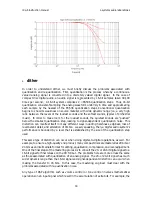
rdq-6 instruction manual
z-systems audio laboratories
11
Transparent Tone Control
For a thorough discussion of equalization, please refer to Appendix A. There, you will find a
complete explanation of concepts such as center frequency, bandwidth, gain, boost, bell
filters, and shelving filters. The reader who is familiar with these concepts may skip Appendix
A and proceed with the following.
Of all the rdq-6’s functions, the transparent tone control merits the most in-depth discussion.
Most high-end audio equipment does not include any form of tone control. There are several
reasons for this, but the simplest is that a tone control would require additional circuitry in the
signal path, which would lead to audible degradation of the audio signal. This reasoning is
indeed correct for tone controls, which work in the analog domain. The rdq-6, however,
works entirely in the digital domain. Z-Systems has developed a very sophisticated tone
control algorithm we call Transparent Tone Control (TTC) and the TTC facility built into the
rdq-6 is its most important feature. TTC is actually more than a tone control; it's a complete
digital-domain parametric equalizer that can be used subtly for speaker correction,
dramatically for room correction, or artistically, to sculpt the signal and make it sound the way
you want it to sound.
You may have a negative impression of digital-domain tone control; indeed, there have been
many poor implementations in the past. Rest assured: we're confident you'll find TTC to be
free from any non-beneficial coloration and to be the finest tone control you've ever heard.
TTC is a direct implementation of the digital equalization algorithm used in our line of
professional disc mastering equalizers. In fact, there's a good chance many of your compact
discs were prepared using one of our equalizers and that TTC was used in the preparation of
many of your favorite compact discs.
•
selecting filters
The TTC provides you with 4 completely independent bell filters, a high-shelf filter, and a low-
shelf filter per channel. Let's first talk about the bell filters. You have a fairly wide range of
control on each of the parameters for the bell filters. The center frequencies range from 28 Hz
to 18 kHz, giving you 56 possible values spaced uniformly on one-sixth octave centers. The
gain at the center frequency ranges from a maximum of +12 dB boost to a minimum of -95 dB
cut. Finally, you have 12 values of slope which typically correspond to values of Q between
0.4 and 8.0. These parameters allow you to generate fairly complicated frequency-domain
profiles, ranging from precisely located notches to broad, sweeping curves. The low- and
high-shelf filters can have their corner frequencies placed at the same numerical values as the
center frequencies for the bell filters. The boost and cut similarly range from +12 dB to -95 dB.


























